UNCC300 Assessment Task 3: Analysis of Disability Exclusion in Society
VerifiedAdded on 2022/08/20
|9
|1856
|19
Report
AI Summary
This report, prepared for UNCC300, addresses the critical issue of excluding people with disabilities from various aspects of society, focusing on the principle of the common good. It explores discrimination in areas like education, healthcare, and employment, particularly within the nursing profession. The report critically evaluates the problem, highlighting the impact of discrimination on disabled individuals' access to opportunities and their experiences in healthcare settings. It proposes strategies to combat exclusion, including raising awareness, implementing inclusive policies, monitoring attitudes, enforcing consequences for discriminatory actions, educating disabled people about their rights, and adapting workplaces to accommodate diverse needs. The report emphasizes the importance of shared responsibility among all stakeholders and advocates for a society where disability is not a barrier to equal participation and opportunity. References include various research papers and articles that support the arguments presented in the report.
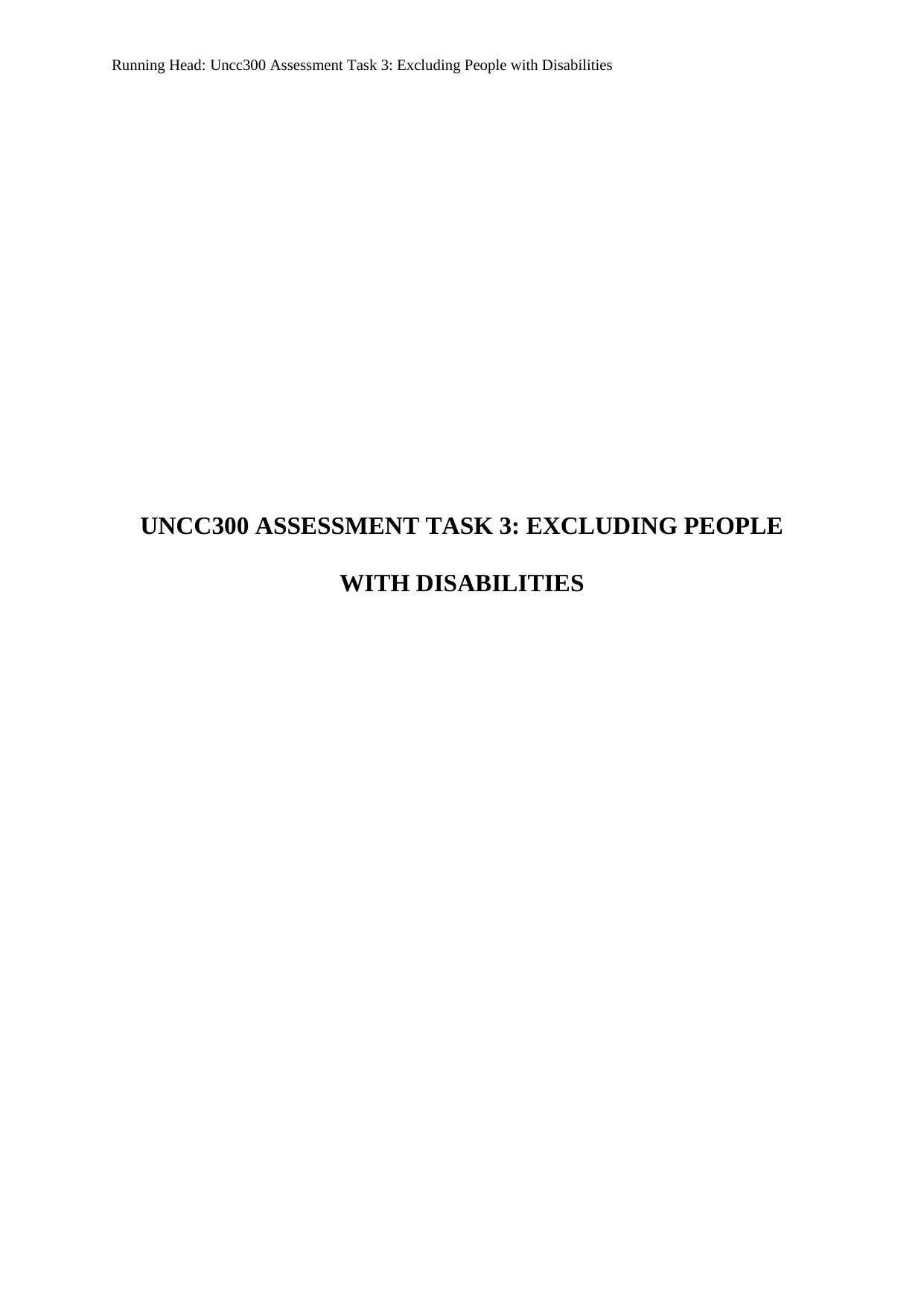
Running Head: Uncc300 Assessment Task 3: Excluding People with Disabilities
UNCC300 ASSESSMENT TASK 3: EXCLUDING PEOPLE
WITH DISABILITIES
UNCC300 ASSESSMENT TASK 3: EXCLUDING PEOPLE
WITH DISABILITIES
Paraphrase This Document
Need a fresh take? Get an instant paraphrase of this document with our AI Paraphraser
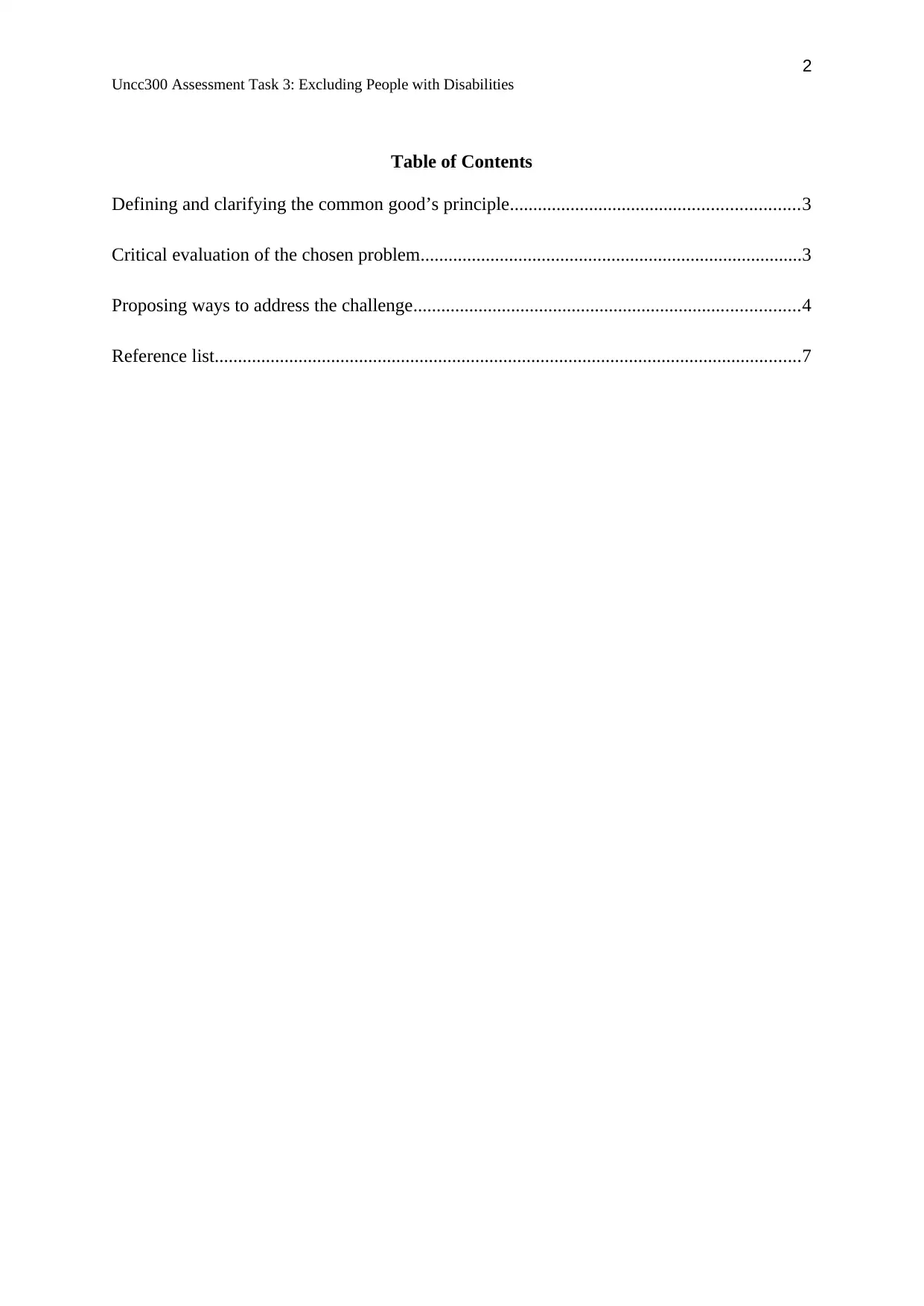
2
Uncc300 Assessment Task 3: Excluding People with Disabilities
Table of Contents
Defining and clarifying the common good’s principle..............................................................3
Critical evaluation of the chosen problem..................................................................................3
Proposing ways to address the challenge...................................................................................4
Reference list..............................................................................................................................7
Uncc300 Assessment Task 3: Excluding People with Disabilities
Table of Contents
Defining and clarifying the common good’s principle..............................................................3
Critical evaluation of the chosen problem..................................................................................3
Proposing ways to address the challenge...................................................................................4
Reference list..............................................................................................................................7
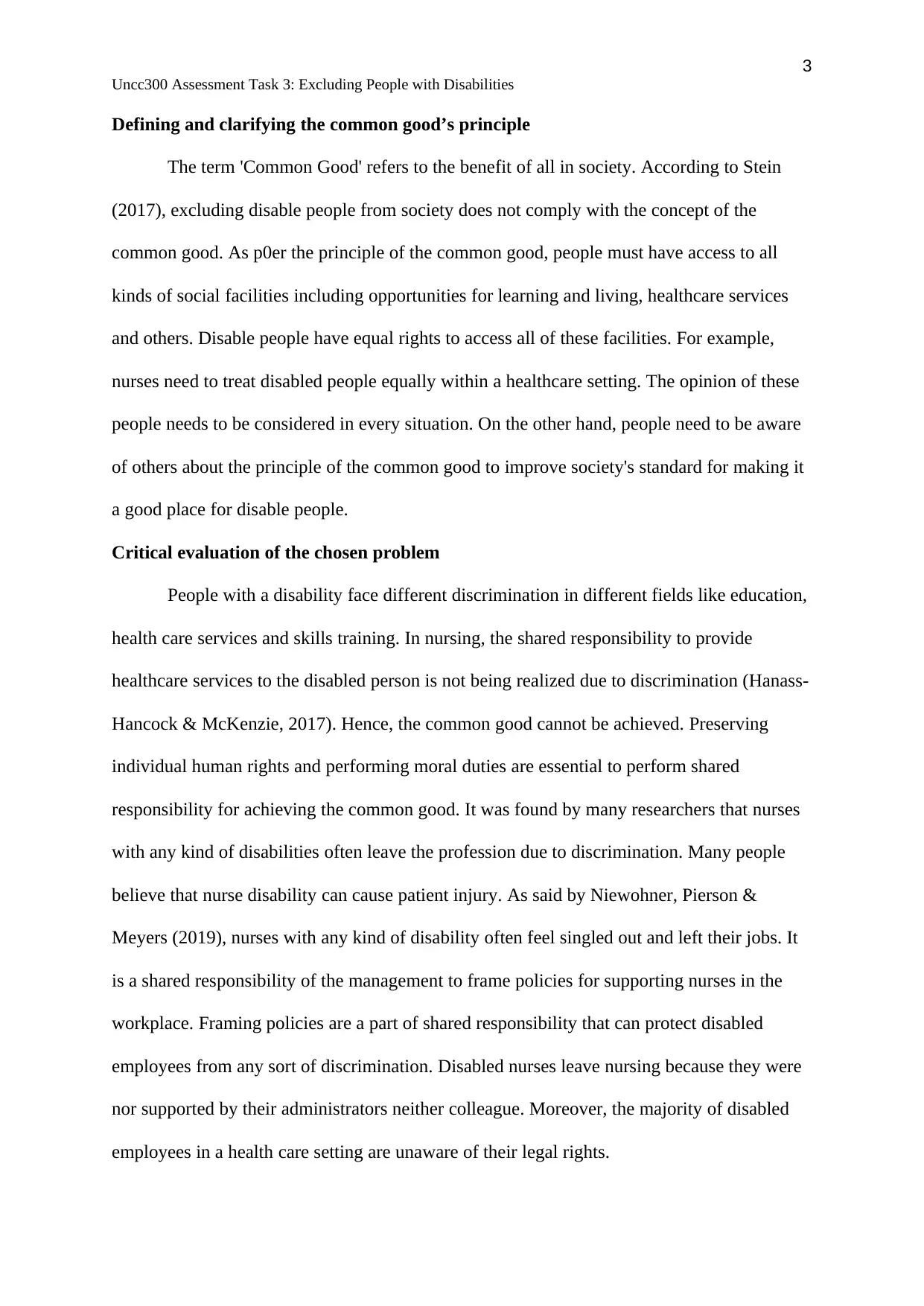
3
Uncc300 Assessment Task 3: Excluding People with Disabilities
Defining and clarifying the common good’s principle
The term 'Common Good' refers to the benefit of all in society. According to Stein
(2017), excluding disable people from society does not comply with the concept of the
common good. As p0er the principle of the common good, people must have access to all
kinds of social facilities including opportunities for learning and living, healthcare services
and others. Disable people have equal rights to access all of these facilities. For example,
nurses need to treat disabled people equally within a healthcare setting. The opinion of these
people needs to be considered in every situation. On the other hand, people need to be aware
of others about the principle of the common good to improve society's standard for making it
a good place for disable people.
Critical evaluation of the chosen problem
People with a disability face different discrimination in different fields like education,
health care services and skills training. In nursing, the shared responsibility to provide
healthcare services to the disabled person is not being realized due to discrimination (Hanass-
Hancock & McKenzie, 2017). Hence, the common good cannot be achieved. Preserving
individual human rights and performing moral duties are essential to perform shared
responsibility for achieving the common good. It was found by many researchers that nurses
with any kind of disabilities often leave the profession due to discrimination. Many people
believe that nurse disability can cause patient injury. As said by Niewohner, Pierson &
Meyers (2019), nurses with any kind of disability often feel singled out and left their jobs. It
is a shared responsibility of the management to frame policies for supporting nurses in the
workplace. Framing policies are a part of shared responsibility that can protect disabled
employees from any sort of discrimination. Disabled nurses leave nursing because they were
nor supported by their administrators neither colleague. Moreover, the majority of disabled
employees in a health care setting are unaware of their legal rights.
Uncc300 Assessment Task 3: Excluding People with Disabilities
Defining and clarifying the common good’s principle
The term 'Common Good' refers to the benefit of all in society. According to Stein
(2017), excluding disable people from society does not comply with the concept of the
common good. As p0er the principle of the common good, people must have access to all
kinds of social facilities including opportunities for learning and living, healthcare services
and others. Disable people have equal rights to access all of these facilities. For example,
nurses need to treat disabled people equally within a healthcare setting. The opinion of these
people needs to be considered in every situation. On the other hand, people need to be aware
of others about the principle of the common good to improve society's standard for making it
a good place for disable people.
Critical evaluation of the chosen problem
People with a disability face different discrimination in different fields like education,
health care services and skills training. In nursing, the shared responsibility to provide
healthcare services to the disabled person is not being realized due to discrimination (Hanass-
Hancock & McKenzie, 2017). Hence, the common good cannot be achieved. Preserving
individual human rights and performing moral duties are essential to perform shared
responsibility for achieving the common good. It was found by many researchers that nurses
with any kind of disabilities often leave the profession due to discrimination. Many people
believe that nurse disability can cause patient injury. As said by Niewohner, Pierson &
Meyers (2019), nurses with any kind of disability often feel singled out and left their jobs. It
is a shared responsibility of the management to frame policies for supporting nurses in the
workplace. Framing policies are a part of shared responsibility that can protect disabled
employees from any sort of discrimination. Disabled nurses leave nursing because they were
nor supported by their administrators neither colleague. Moreover, the majority of disabled
employees in a health care setting are unaware of their legal rights.
⊘ This is a preview!⊘
Do you want full access?
Subscribe today to unlock all pages.

Trusted by 1+ million students worldwide
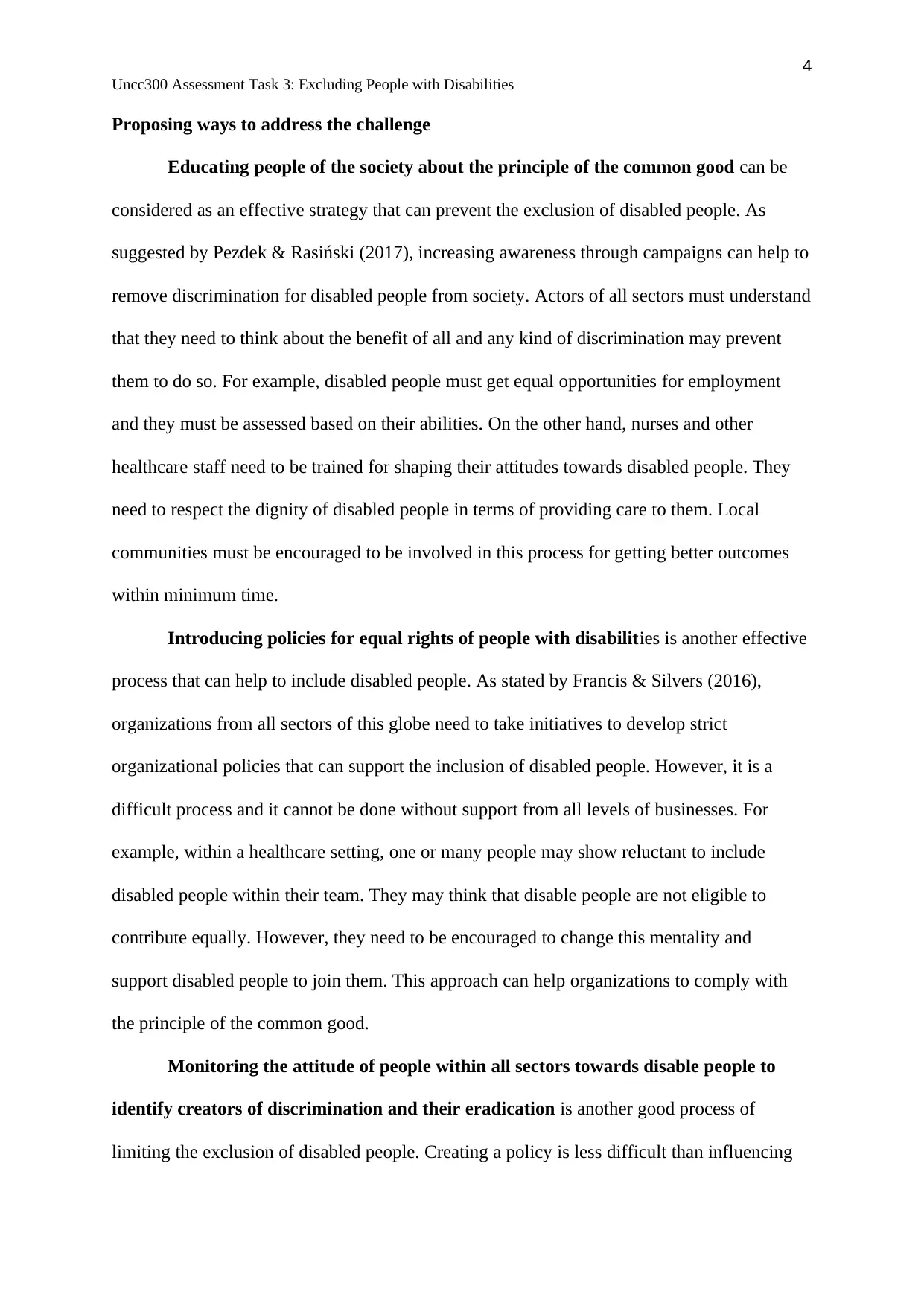
4
Uncc300 Assessment Task 3: Excluding People with Disabilities
Proposing ways to address the challenge
Educating people of the society about the principle of the common good can be
considered as an effective strategy that can prevent the exclusion of disabled people. As
suggested by Pezdek & Rasiński (2017), increasing awareness through campaigns can help to
remove discrimination for disabled people from society. Actors of all sectors must understand
that they need to think about the benefit of all and any kind of discrimination may prevent
them to do so. For example, disabled people must get equal opportunities for employment
and they must be assessed based on their abilities. On the other hand, nurses and other
healthcare staff need to be trained for shaping their attitudes towards disabled people. They
need to respect the dignity of disabled people in terms of providing care to them. Local
communities must be encouraged to be involved in this process for getting better outcomes
within minimum time.
Introducing policies for equal rights of people with disabilities is another effective
process that can help to include disabled people. As stated by Francis & Silvers (2016),
organizations from all sectors of this globe need to take initiatives to develop strict
organizational policies that can support the inclusion of disabled people. However, it is a
difficult process and it cannot be done without support from all levels of businesses. For
example, within a healthcare setting, one or many people may show reluctant to include
disabled people within their team. They may think that disable people are not eligible to
contribute equally. However, they need to be encouraged to change this mentality and
support disabled people to join them. This approach can help organizations to comply with
the principle of the common good.
Monitoring the attitude of people within all sectors towards disable people to
identify creators of discrimination and their eradication is another good process of
limiting the exclusion of disabled people. Creating a policy is less difficult than influencing
Uncc300 Assessment Task 3: Excluding People with Disabilities
Proposing ways to address the challenge
Educating people of the society about the principle of the common good can be
considered as an effective strategy that can prevent the exclusion of disabled people. As
suggested by Pezdek & Rasiński (2017), increasing awareness through campaigns can help to
remove discrimination for disabled people from society. Actors of all sectors must understand
that they need to think about the benefit of all and any kind of discrimination may prevent
them to do so. For example, disabled people must get equal opportunities for employment
and they must be assessed based on their abilities. On the other hand, nurses and other
healthcare staff need to be trained for shaping their attitudes towards disabled people. They
need to respect the dignity of disabled people in terms of providing care to them. Local
communities must be encouraged to be involved in this process for getting better outcomes
within minimum time.
Introducing policies for equal rights of people with disabilities is another effective
process that can help to include disabled people. As stated by Francis & Silvers (2016),
organizations from all sectors of this globe need to take initiatives to develop strict
organizational policies that can support the inclusion of disabled people. However, it is a
difficult process and it cannot be done without support from all levels of businesses. For
example, within a healthcare setting, one or many people may show reluctant to include
disabled people within their team. They may think that disable people are not eligible to
contribute equally. However, they need to be encouraged to change this mentality and
support disabled people to join them. This approach can help organizations to comply with
the principle of the common good.
Monitoring the attitude of people within all sectors towards disable people to
identify creators of discrimination and their eradication is another good process of
limiting the exclusion of disabled people. Creating a policy is less difficult than influencing
Paraphrase This Document
Need a fresh take? Get an instant paraphrase of this document with our AI Paraphraser
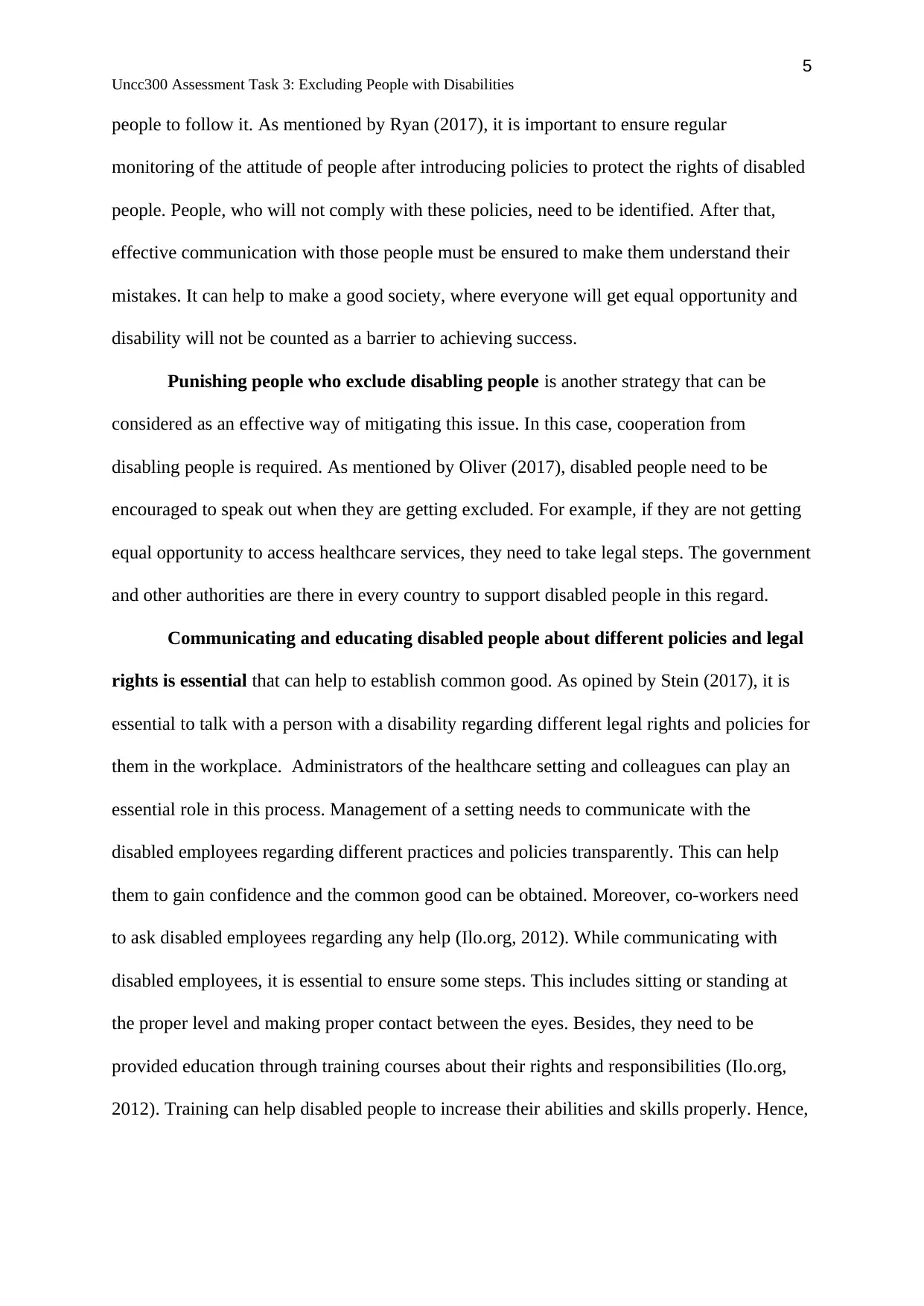
5
Uncc300 Assessment Task 3: Excluding People with Disabilities
people to follow it. As mentioned by Ryan (2017), it is important to ensure regular
monitoring of the attitude of people after introducing policies to protect the rights of disabled
people. People, who will not comply with these policies, need to be identified. After that,
effective communication with those people must be ensured to make them understand their
mistakes. It can help to make a good society, where everyone will get equal opportunity and
disability will not be counted as a barrier to achieving success.
Punishing people who exclude disabling people is another strategy that can be
considered as an effective way of mitigating this issue. In this case, cooperation from
disabling people is required. As mentioned by Oliver (2017), disabled people need to be
encouraged to speak out when they are getting excluded. For example, if they are not getting
equal opportunity to access healthcare services, they need to take legal steps. The government
and other authorities are there in every country to support disabled people in this regard.
Communicating and educating disabled people about different policies and legal
rights is essential that can help to establish common good. As opined by Stein (2017), it is
essential to talk with a person with a disability regarding different legal rights and policies for
them in the workplace. Administrators of the healthcare setting and colleagues can play an
essential role in this process. Management of a setting needs to communicate with the
disabled employees regarding different practices and policies transparently. This can help
them to gain confidence and the common good can be obtained. Moreover, co-workers need
to ask disabled employees regarding any help (Ilo.org, 2012). While communicating with
disabled employees, it is essential to ensure some steps. This includes sitting or standing at
the proper level and making proper contact between the eyes. Besides, they need to be
provided education through training courses about their rights and responsibilities (Ilo.org,
2012). Training can help disabled people to increase their abilities and skills properly. Hence,
Uncc300 Assessment Task 3: Excluding People with Disabilities
people to follow it. As mentioned by Ryan (2017), it is important to ensure regular
monitoring of the attitude of people after introducing policies to protect the rights of disabled
people. People, who will not comply with these policies, need to be identified. After that,
effective communication with those people must be ensured to make them understand their
mistakes. It can help to make a good society, where everyone will get equal opportunity and
disability will not be counted as a barrier to achieving success.
Punishing people who exclude disabling people is another strategy that can be
considered as an effective way of mitigating this issue. In this case, cooperation from
disabling people is required. As mentioned by Oliver (2017), disabled people need to be
encouraged to speak out when they are getting excluded. For example, if they are not getting
equal opportunity to access healthcare services, they need to take legal steps. The government
and other authorities are there in every country to support disabled people in this regard.
Communicating and educating disabled people about different policies and legal
rights is essential that can help to establish common good. As opined by Stein (2017), it is
essential to talk with a person with a disability regarding different legal rights and policies for
them in the workplace. Administrators of the healthcare setting and colleagues can play an
essential role in this process. Management of a setting needs to communicate with the
disabled employees regarding different practices and policies transparently. This can help
them to gain confidence and the common good can be obtained. Moreover, co-workers need
to ask disabled employees regarding any help (Ilo.org, 2012). While communicating with
disabled employees, it is essential to ensure some steps. This includes sitting or standing at
the proper level and making proper contact between the eyes. Besides, they need to be
provided education through training courses about their rights and responsibilities (Ilo.org,
2012). Training can help disabled people to increase their abilities and skills properly. Hence,
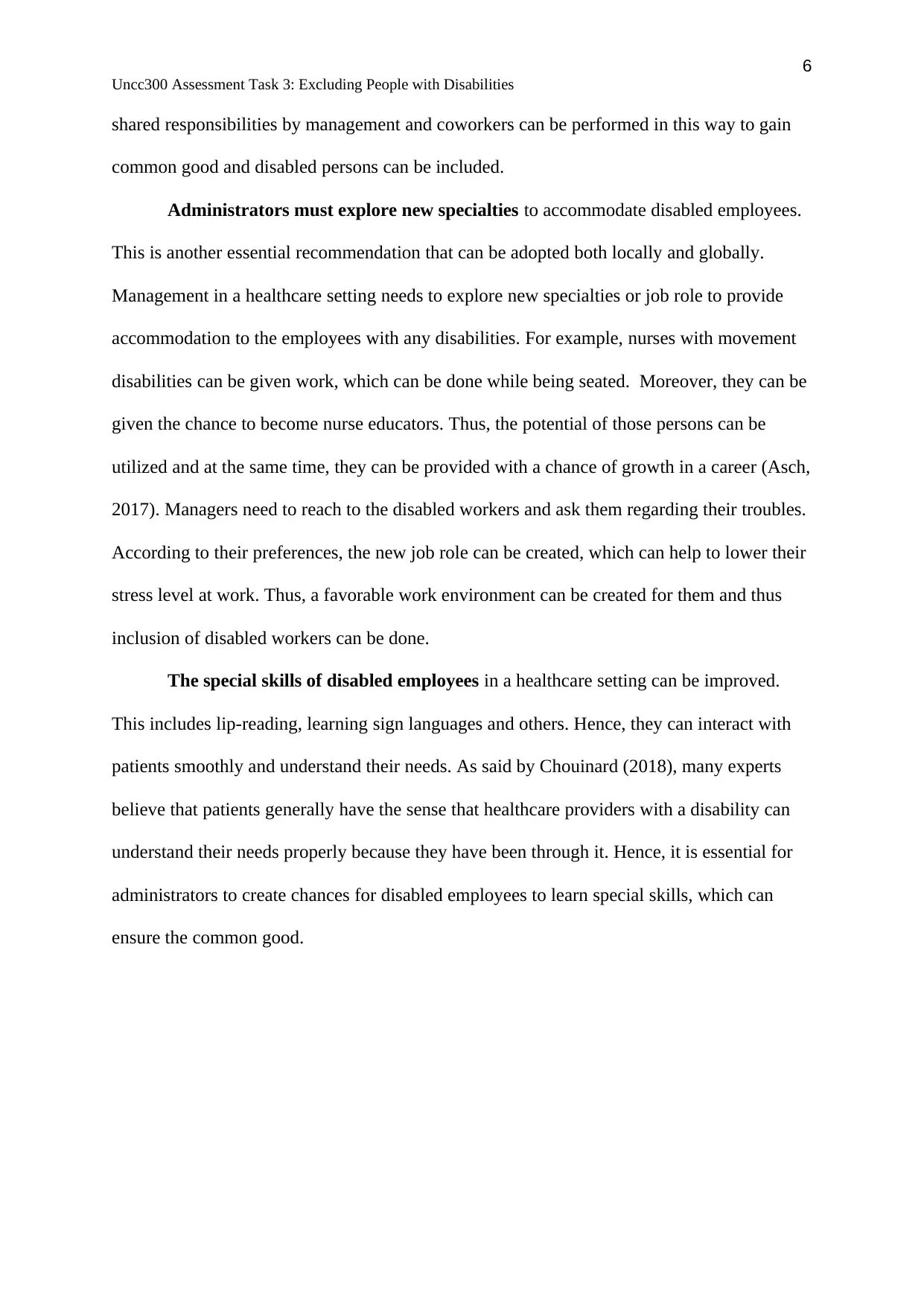
6
Uncc300 Assessment Task 3: Excluding People with Disabilities
shared responsibilities by management and coworkers can be performed in this way to gain
common good and disabled persons can be included.
Administrators must explore new specialties to accommodate disabled employees.
This is another essential recommendation that can be adopted both locally and globally.
Management in a healthcare setting needs to explore new specialties or job role to provide
accommodation to the employees with any disabilities. For example, nurses with movement
disabilities can be given work, which can be done while being seated. Moreover, they can be
given the chance to become nurse educators. Thus, the potential of those persons can be
utilized and at the same time, they can be provided with a chance of growth in a career (Asch,
2017). Managers need to reach to the disabled workers and ask them regarding their troubles.
According to their preferences, the new job role can be created, which can help to lower their
stress level at work. Thus, a favorable work environment can be created for them and thus
inclusion of disabled workers can be done.
The special skills of disabled employees in a healthcare setting can be improved.
This includes lip-reading, learning sign languages and others. Hence, they can interact with
patients smoothly and understand their needs. As said by Chouinard (2018), many experts
believe that patients generally have the sense that healthcare providers with a disability can
understand their needs properly because they have been through it. Hence, it is essential for
administrators to create chances for disabled employees to learn special skills, which can
ensure the common good.
Uncc300 Assessment Task 3: Excluding People with Disabilities
shared responsibilities by management and coworkers can be performed in this way to gain
common good and disabled persons can be included.
Administrators must explore new specialties to accommodate disabled employees.
This is another essential recommendation that can be adopted both locally and globally.
Management in a healthcare setting needs to explore new specialties or job role to provide
accommodation to the employees with any disabilities. For example, nurses with movement
disabilities can be given work, which can be done while being seated. Moreover, they can be
given the chance to become nurse educators. Thus, the potential of those persons can be
utilized and at the same time, they can be provided with a chance of growth in a career (Asch,
2017). Managers need to reach to the disabled workers and ask them regarding their troubles.
According to their preferences, the new job role can be created, which can help to lower their
stress level at work. Thus, a favorable work environment can be created for them and thus
inclusion of disabled workers can be done.
The special skills of disabled employees in a healthcare setting can be improved.
This includes lip-reading, learning sign languages and others. Hence, they can interact with
patients smoothly and understand their needs. As said by Chouinard (2018), many experts
believe that patients generally have the sense that healthcare providers with a disability can
understand their needs properly because they have been through it. Hence, it is essential for
administrators to create chances for disabled employees to learn special skills, which can
ensure the common good.
⊘ This is a preview!⊘
Do you want full access?
Subscribe today to unlock all pages.

Trusted by 1+ million students worldwide
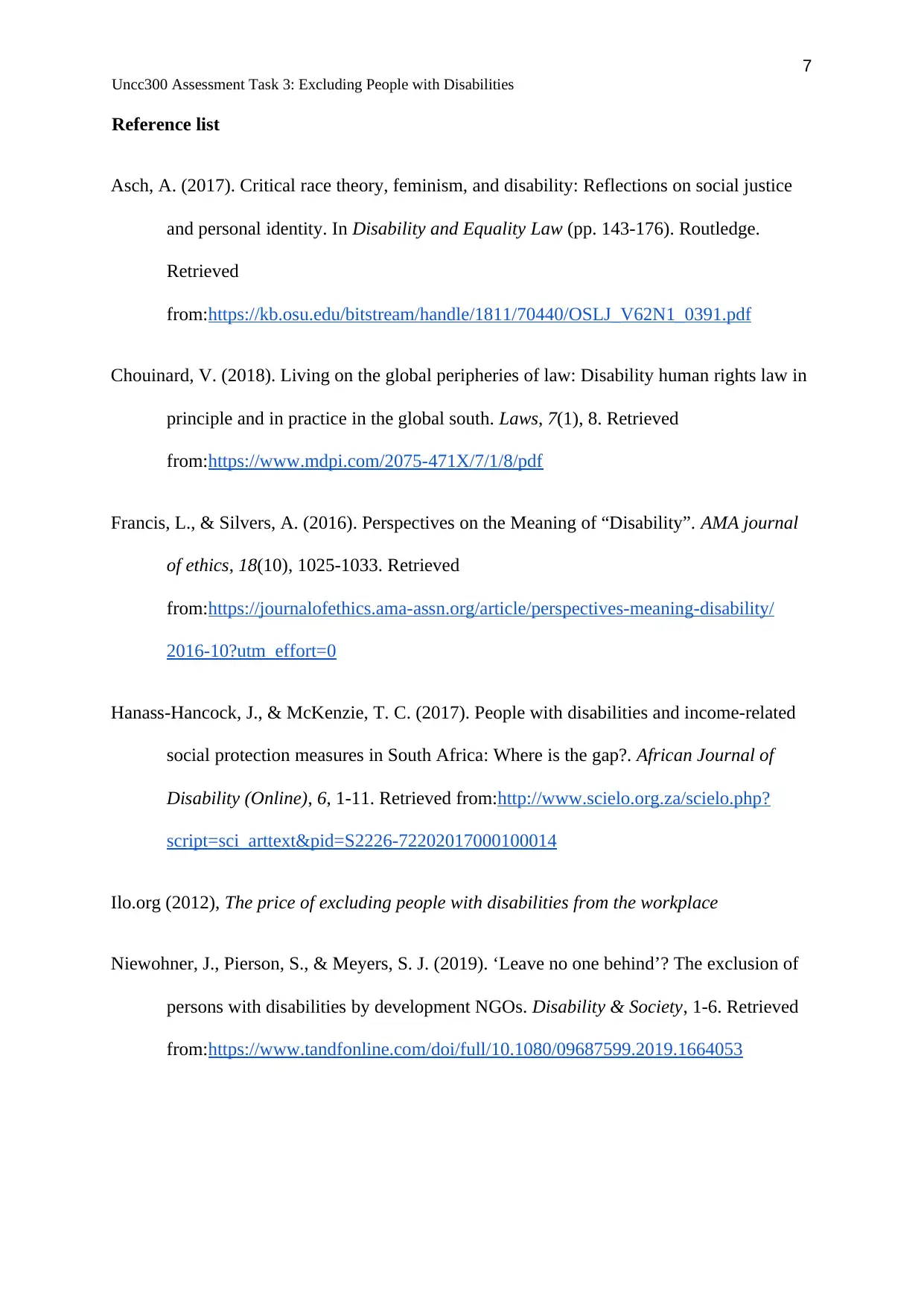
7
Uncc300 Assessment Task 3: Excluding People with Disabilities
Reference list
Asch, A. (2017). Critical race theory, feminism, and disability: Reflections on social justice
and personal identity. In Disability and Equality Law (pp. 143-176). Routledge.
Retrieved
from:https://kb.osu.edu/bitstream/handle/1811/70440/OSLJ_V62N1_0391.pdf
Chouinard, V. (2018). Living on the global peripheries of law: Disability human rights law in
principle and in practice in the global south. Laws, 7(1), 8. Retrieved
from:https://www.mdpi.com/2075-471X/7/1/8/pdf
Francis, L., & Silvers, A. (2016). Perspectives on the Meaning of “Disability”. AMA journal
of ethics, 18(10), 1025-1033. Retrieved
from:https://journalofethics.ama-assn.org/article/perspectives-meaning-disability/
2016-10?utm_effort=0
Hanass-Hancock, J., & McKenzie, T. C. (2017). People with disabilities and income-related
social protection measures in South Africa: Where is the gap?. African Journal of
Disability (Online), 6, 1-11. Retrieved from:http://www.scielo.org.za/scielo.php?
script=sci_arttext&pid=S2226-72202017000100014
Ilo.org (2012), The price of excluding people with disabilities from the workplace
Niewohner, J., Pierson, S., & Meyers, S. J. (2019). ‘Leave no one behind’? The exclusion of
persons with disabilities by development NGOs. Disability & Society, 1-6. Retrieved
from:https://www.tandfonline.com/doi/full/10.1080/09687599.2019.1664053
Uncc300 Assessment Task 3: Excluding People with Disabilities
Reference list
Asch, A. (2017). Critical race theory, feminism, and disability: Reflections on social justice
and personal identity. In Disability and Equality Law (pp. 143-176). Routledge.
Retrieved
from:https://kb.osu.edu/bitstream/handle/1811/70440/OSLJ_V62N1_0391.pdf
Chouinard, V. (2018). Living on the global peripheries of law: Disability human rights law in
principle and in practice in the global south. Laws, 7(1), 8. Retrieved
from:https://www.mdpi.com/2075-471X/7/1/8/pdf
Francis, L., & Silvers, A. (2016). Perspectives on the Meaning of “Disability”. AMA journal
of ethics, 18(10), 1025-1033. Retrieved
from:https://journalofethics.ama-assn.org/article/perspectives-meaning-disability/
2016-10?utm_effort=0
Hanass-Hancock, J., & McKenzie, T. C. (2017). People with disabilities and income-related
social protection measures in South Africa: Where is the gap?. African Journal of
Disability (Online), 6, 1-11. Retrieved from:http://www.scielo.org.za/scielo.php?
script=sci_arttext&pid=S2226-72202017000100014
Ilo.org (2012), The price of excluding people with disabilities from the workplace
Niewohner, J., Pierson, S., & Meyers, S. J. (2019). ‘Leave no one behind’? The exclusion of
persons with disabilities by development NGOs. Disability & Society, 1-6. Retrieved
from:https://www.tandfonline.com/doi/full/10.1080/09687599.2019.1664053
Paraphrase This Document
Need a fresh take? Get an instant paraphrase of this document with our AI Paraphraser
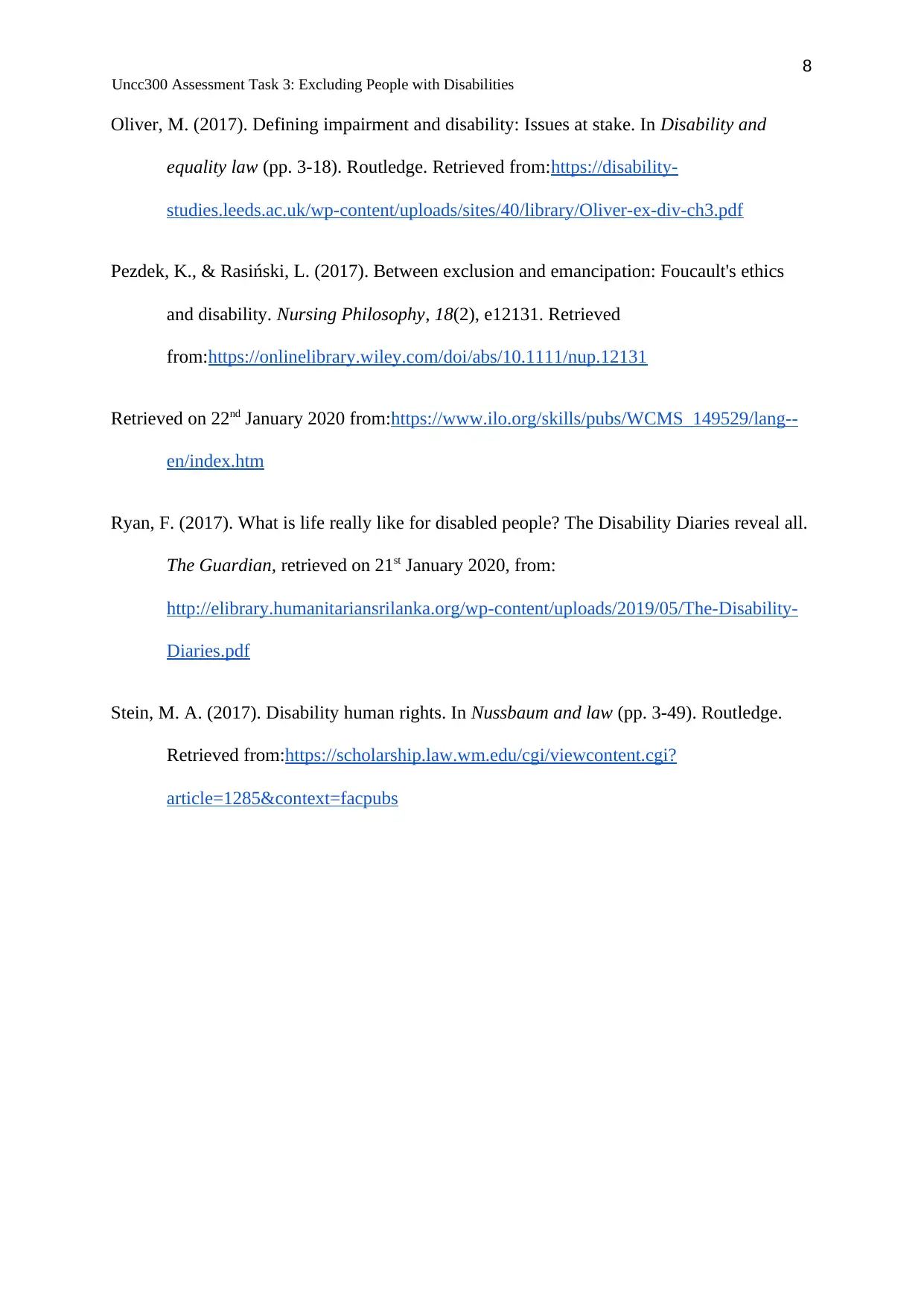
8
Uncc300 Assessment Task 3: Excluding People with Disabilities
Oliver, M. (2017). Defining impairment and disability: Issues at stake. In Disability and
equality law (pp. 3-18). Routledge. Retrieved from:https://disability-
studies.leeds.ac.uk/wp-content/uploads/sites/40/library/Oliver-ex-div-ch3.pdf
Pezdek, K., & Rasiński, L. (2017). Between exclusion and emancipation: Foucault's ethics
and disability. Nursing Philosophy, 18(2), e12131. Retrieved
from:https://onlinelibrary.wiley.com/doi/abs/10.1111/nup.12131
Retrieved on 22nd January 2020 from:https://www.ilo.org/skills/pubs/WCMS_149529/lang--
en/index.htm
Ryan, F. (2017). What is life really like for disabled people? The Disability Diaries reveal all.
The Guardian, retrieved on 21st January 2020, from:
http://elibrary.humanitariansrilanka.org/wp-content/uploads/2019/05/The-Disability-
Diaries.pdf
Stein, M. A. (2017). Disability human rights. In Nussbaum and law (pp. 3-49). Routledge.
Retrieved from:https://scholarship.law.wm.edu/cgi/viewcontent.cgi?
article=1285&context=facpubs
Uncc300 Assessment Task 3: Excluding People with Disabilities
Oliver, M. (2017). Defining impairment and disability: Issues at stake. In Disability and
equality law (pp. 3-18). Routledge. Retrieved from:https://disability-
studies.leeds.ac.uk/wp-content/uploads/sites/40/library/Oliver-ex-div-ch3.pdf
Pezdek, K., & Rasiński, L. (2017). Between exclusion and emancipation: Foucault's ethics
and disability. Nursing Philosophy, 18(2), e12131. Retrieved
from:https://onlinelibrary.wiley.com/doi/abs/10.1111/nup.12131
Retrieved on 22nd January 2020 from:https://www.ilo.org/skills/pubs/WCMS_149529/lang--
en/index.htm
Ryan, F. (2017). What is life really like for disabled people? The Disability Diaries reveal all.
The Guardian, retrieved on 21st January 2020, from:
http://elibrary.humanitariansrilanka.org/wp-content/uploads/2019/05/The-Disability-
Diaries.pdf
Stein, M. A. (2017). Disability human rights. In Nussbaum and law (pp. 3-49). Routledge.
Retrieved from:https://scholarship.law.wm.edu/cgi/viewcontent.cgi?
article=1285&context=facpubs

9
Uncc300 Assessment Task 3: Excluding People with Disabilities
Uncc300 Assessment Task 3: Excluding People with Disabilities
⊘ This is a preview!⊘
Do you want full access?
Subscribe today to unlock all pages.

Trusted by 1+ million students worldwide
1 out of 9
Related Documents
Your All-in-One AI-Powered Toolkit for Academic Success.
+13062052269
info@desklib.com
Available 24*7 on WhatsApp / Email
![[object Object]](/_next/static/media/star-bottom.7253800d.svg)
Unlock your academic potential
Copyright © 2020–2025 A2Z Services. All Rights Reserved. Developed and managed by ZUCOL.





